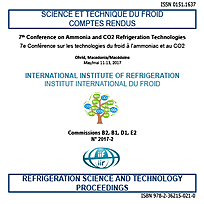
Document IIF
Comparaison des économies d’énergie générées par les systèmes de dégivrage par gaz chauds à pression régulée et à drainage de liquide régulé.
Energy saving comparing pressure controlled and liquid drain controlled hot gas defrost.
Numéro : pap. n. 0007
Auteurs : SKOVRUP M., WRONSKI J., VESTERGAARD N., et al.
Résumé
Traditionally two methods for controlling drainage of the evaporator during hot gas defrost are used: Pressure control, which keeps the pressure in the evaporator constant during defrost and liquid drain control, which uses a float to drain condensed liquid from the evaporator. The energy consumption using the two methods is quite different, as the pressure control method bypasses a certain amount of hot gas at the end of the defrost period. This paper presents a model, which quantifies the energy consumption during the two methods, and discuss the influence of operating conditions and evaporator design. The results from the model are validated against laboratory measurements on two evaporators with different pipe arrangements. Detailed laboratory test on ammonia defrost system has been conducted as a part of the ELFORSK project 347-030.
Documents disponibles
Format PDF
Pages : 8
Disponible
Prix public
20 €
Prix membre*
Gratuit
* meilleur tarif applicable selon le type d'adhésion (voir le détail des avantages des adhésions individuelles et collectives)
Détails
- Titre original : Energy saving comparing pressure controlled and liquid drain controlled hot gas defrost.
- Identifiant de la fiche : 30021637
- Langues : Anglais
- Source : 7th Conference on Ammonia and CO2 Refrigeration Technology. Proceedings: Ohrid, North Macedonia, May 11-13, 2017.
- Date d'édition : 11/05/2017
- DOI : http://dx.doi.org/10.18462/iir.nh3-co2.2017.0007
- Document disponible en consultation à la bibliothèque du siège de l'IIF uniquement.
Liens
Voir d'autres communications du même compte rendu (42)
Voir le compte rendu de la conférence
Indexation
-
Thèmes :
Evaporateurs, condenseurs et autres échangeurs thermiques;
Circulation du fluide : tuyauterie, régulation, automatisme, sécurité;
Systèmes de dégivrage - Mots-clés : Robinet; Système frigorifique; Canalisation; Gaz chaud; Coefficient de transfert de chaleur; Modélisation; Évaporateur; Économie d'energie; Dégivrage
-
INFLUENCE OF FROST FORMATION ON THE PERFORMANCE...
- Auteurs : IVANOVA V. S., GATCHILOV T. S.
- Date : 26/05/1982
- Langues : Anglais
- Formats : PDF
Voir la fiche
-
Investigation of the dynamic heat transfer coef...
- Auteurs : RÜCKERT J. P., SCHMITZ G.
- Date : 14/07/2014
- Langues : Anglais
- Source : 2014 Purdue Conferences. 15th International Refrigeration and Air-Conditioning Conference at Purdue.
- Formats : PDF
Voir la fiche
-
EVAPORATOR MODELS FOR OPERATION WITH DRY, WET, ...
- Auteurs : OSKARSSON S. P., KRAKOV K. I., LIN S.
- Date : 1990
- Langues : Anglais
Voir la fiche
-
The effect of frost accumulation on the perform...
- Auteurs : RITE R. W., CRAWFORD R. R.
- Date : 1991
- Langues : Anglais
Voir la fiche
-
A model of hot-gas defrosting of evaporators. 1...
- Auteurs : KRAKOW K. I., YAN L., LIN S.
- Date : 1992
- Langues : Anglais
Voir la fiche
